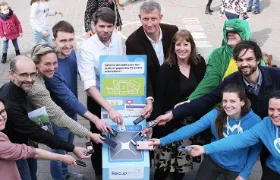The Future Is Circular
Hans Schurmans is Logistics Operations Division Lead at Proximus. In this article he details how Proximus has integrated recycling and refurbishment of equipment used by its customers into its operations, and what other ambitions the company intends to realise to help create a truly circular economy.
Hans Schurmans
My LinkedIn profile
Proximus has the ambition to become truly circular in its production and logistics. But what does that mean? As the one in charge of this transformation, I went looking for a definition for truly circular. Turns out there isn't one. It's arguably easy to reach a target if you get to define that target yourself. Unfortunately, rather than making my own life easier, my team and I came up with a definition that will require sustained effort, collaboration and coordination to achieve.
Don't get me wrong – all that effort is worth it, as we have already been busy with circularity for a long time and achieved a lot. Circularity is the future, and working towards it should be a no-brainer in any modern company. When devices can be used for longer or their components recycled, you save significantly on raw materials, production, and transport. Apart from the obvious sustainability win, a circular model can save you a lot – as it already does at Proximus. It just requires some proper thought and investment across areas including design, partnerships, logistics and warehouse setup, amongst others. Let me break it down for you.
The starting point: circular design
To trace the origins of Proximus' evolution towards circularity, we need to go back in time to about ten years ago. That's when we first started investing in the refurbishment and recycling of our mass-market customer premises equipment (CPE): decoders, modems, cables, etc. Since the customer rents these devices from us, they are easy to retrieve (as opposed to client-owned ones like smartphones). They are also comparatively simple devices and therefore relatively straightforward to refurbish and recycle.
I say relatively straightforward, but there are always gains to be made in terms of efficiency. One aspect of this is circular design. Through the years, we have made circular design a requirement for our partners and suppliers. That sounds fancy, but it essentially means that one of the things we take into account during the design phase is the refurbishing process. A few examples: making the Wi-Fi component in a modem easily replaceable to facilitate future upgrades or replacing easily breakable plastic clips with metal screws for longevity.
Circular design like this essentially makes our jobs easier: the resulting devices are simpler to test, easier to repair, and quicker to deconstruct when they finally get to the end of their lifecycle. But it's not just devices that benefit from circular design: just as many gains can be made in the logistical process. We made the decision to incorporate our refurbishing partner CTDI, which currently processes around 800,000 devices a year, into our distribution center in Courcelles. The transport eliminated thanks to this integration alone, saves us 170 tons of CO₂ as well as a substantial amount of money each year.
The goal: circular production
These interventions in design and logistics are a great start, but on their own, they are not enough. Our current efforts don't quite get us there. No matter how often we repair and refurbish devices or how much we reduce transport needs, any appliance inevitably reaches the end of its lifecycle at some point. At the moment, these exhausted devices are transported to and scrapped by an outside partner.
To be truly circular, we need to go several steps further. We are currently looking into the possibility of in-house disassembly. This would give us full control over the entire lifecycle of our devices. It would also allow us to resell the recovered materials, potentially generating economic gain, and at the very least making sure they are properly and sustainably disposed of. The ultimate dream would be for our suppliers to then re-use the recovered materials to create new devices, making the circle perfectly round.
The vision: a circular economy
There's more we can and want to do here at Proximus. Extend our refurbishing and recycling efforts to more types of devices, for example. But as you can see, true circularity is something we cannot achieve on our own. We depend on partners, suppliers, and consumers for various steps of the process. Convincing them all to join us in the circular story is a big priority for Proximus.
But if we really want to make an impact to combat climate change, not just Proximus, but the entire economy needs to become circular. That means we need to look across traditional divides to our direct competitors. Competition is necessary in our economy, but sustainability is not a suitable arena for it. We need extensive collaboration across the sector and beyond to create a truly sustainable economy – the economy of the future. And that future is circular.


